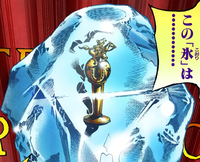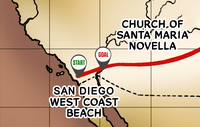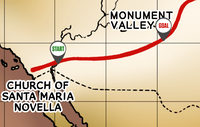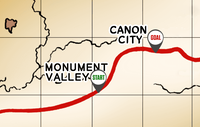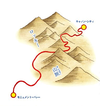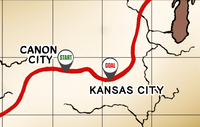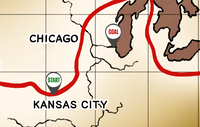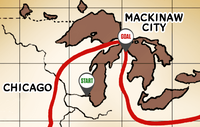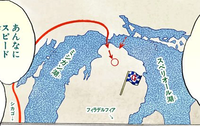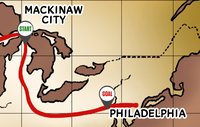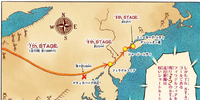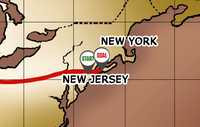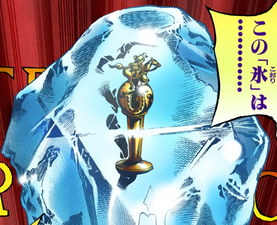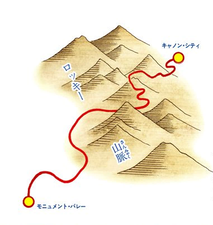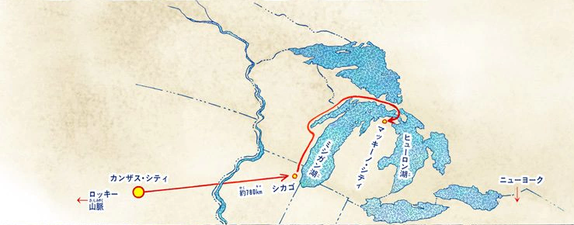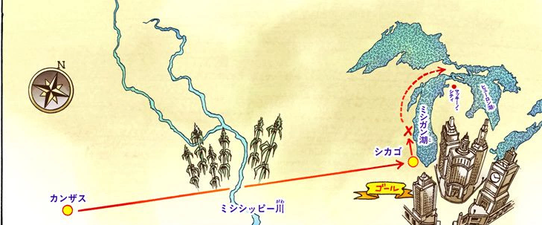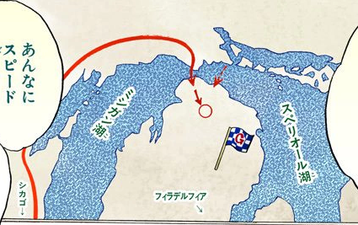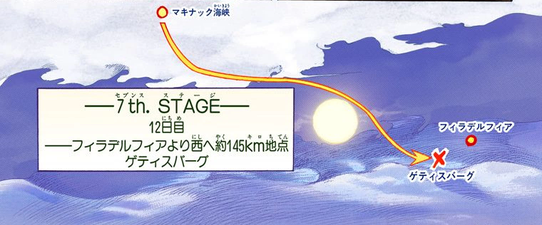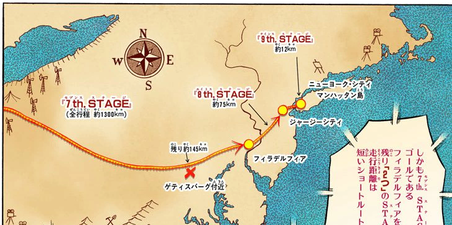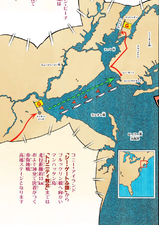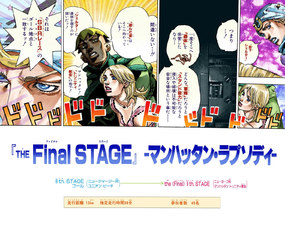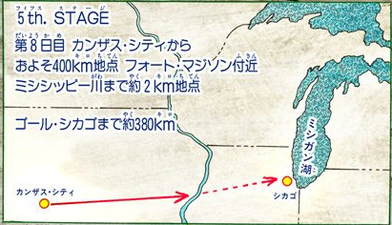Steel Ball Run
La Steel Ball Run (スティールボールラン, Sutīru Bōru Ran) est une course à cheval épique figurant dans la septième partie de JoJo's Bizarre Adventure, Steel Ball Run. La course en entrée libre consiste en une traversée continue des Etats-Unis depuis San Diego en California à New York.
Description
La Steel Ball Run est une course à cheval qui est unique de par l'échelle épique son parcours et des récompenses allouées. En effet, la course s'est faite à travers les Etats-Unis avec pour récompense 50 millions de dollars américain (cours moderne). Au total, 3652 personnes ont participé à la Steel Ball Run.[1]
Règles
La Steel Ball Run est une course ouverte à tous ou presque : n'importe qui est libre de participer quelque soit son âge (avec un minimum de 16 ans), son sexe, sa nationalité, sa race, qu'il soit professionnel ou amateur. Cependant, il y a un prix d'inscription de 1200 dollars, correspondant au salaire mensuel moyen d'un travailleur aux Etats-Unis. Le prix d'inscription est justifié par le fait que l'évènement paiera pour les vivres, les notes d'hôtels, les soins médicaux et même le voyage retour en cas d'abandon pour les participants durant toute la durée de la course. Il n'y a pas de restriction particulière sur le moyen de transport. Ainsi si la plupart des participants font la course à cheval, certains ont essayé d'y participant à dos de dromadaire, sur une automobile ou même à pied. Les participants s'attendent à braver les éléments, que ce soit le torride désert d'Arizona ou le climat glacial du Michigan, et devront quelque fois survivre seul dans la nature.
La course débute le 25 septembre 1890 sur la plage de San Diego, à 10 heure du matin. Elle finit à New York à Manhattan, le 19 janvier 1891. On estime que la distance totale de la course fait 6000 kilomètres, et prendrait de 60 à 80 jours à être parcouru. Le parcours est partagés en 9 étapes distincts délimités par des villes spécifiques.
Il y a certaines règles à respecter pour les compétiteurs durant la course. La première est que la monture ou le véhicule doivent rester les mêmes durant toute la course, sachant que les empreintes du cavalier et de la monture sont enregistrés. Deuxièmement, il est interdit de s'en prendre aux autres participants. Il est toutefois autorisé de porter une arme à feu pour se défendre, conformément au deuxième amendement des Etats-Unis.[1]
Histoire
La course a été organisée et promue par Steven Steel, et soutenue dans l'ombre par le Président des Etats-Unis, Funny Valentine. Si c'est Steven Steel qui a d'abord pensé à organiser une course à cheval durant la période entre 1884 et 1888 de part son expérience dans la cavalerie, c'est en fait la jeune fille Lucy Pendleton qui lui a suggéré d'en faire une course à travers le continent avec une somme d'argent extravagante comme récompense. Steel, qui était un sans-le-sou ivre à l'époque, trouva l'idée ridicule mais par chance il continua à répéter les idées de Lucy et des sponsors furent intéressés par l'idée d'organiser la course, avec Steel à la tête de l'évènement.[2] Cependant, a un moment donné, le gouvernement américain et Funny Valentine se sont secrètement impliqués dans l'organisation de la course et ont détourné l'évènement à leur fin. Ainsi, la Steel Ball Run sert aussi de front pour une opération de recherche des morceaux du Corps Saint, un artefact sacré qui pourrait bénir un pays entier pendant un millénaire, avec plusisuers participants qui opèrent pour Valentine, et le parcours de la course elle-même qui est fait pour suivre comment les morceaux du corps ont été dispersés selon une carte de Joseph d'Arimathie.
La course démarra sans accroc le 25 septembre 1890 à 10 heures du matin San Diego Beach en Californie et finit à New York devant l'Eglise de la Trinité. La distance parcourue fut de 6,000 km (3,700 mi) à travers les Etats-Unis. En parallèle de la course, une violente mais secrète lutte pour les morceaux du Corps Saint s'est déroulée entres les participants et aussi les Subordonnés de Valentine, résultant en la mort de plusieurs compétiteurs. Cependant, le public n'apprit jamais la vérité sur ce qui s'est passé.
La course se conclut le 19 janvier 1891. Diego Brando gagna la course en arrivant le premier à l'Eglise avec le plus grand total de points gagnés. Cependant, il disparut immédiatement après et fut disqualifié lorsqu'il ne se présenta pas à la remise des prix, et ce sans explication apparente. A la place, ce fut Pocoloco qui fut déclaré vainqueur. Des 3652 compétiteurs qui s'étaient inscrits, seul 39 personnes purent finir la course. On estime que la course généra 50 milliards de dollars (ou 7 trillions de yen). La course fut publiquement critiquée à cause de plusieurs morts qui se sont déroulées pendant celle-ci mais les critiques se turent quand Steven Steel offrit tous les revenus de la courses à diverses oeuvres de charité.[3]
Prix et classement
Pour départager le vainqueur, un système de point engrangés durant la course permettra de connaitre le véritable vainqueur de la course, n'étant pas seulement le premier qui atteindra la ligne d'arrivée. A chaque fin d'étape, des points sont données aux compétiteurs selon l'ordre d'arrivée, récompensant leur performance durant cette étape.[4] Lorsque l'ordre d'arrivée n'est pas claire, cinq juges peuvent utiliser une photographie des concurrents alors qu'ils traversent la ligne d'arrivée pour déterminer le classement.[5]
Les points sont données suivant le classement suivant :[5][6]
| Placement | Points | Placement | Points |
|---|---|---|---|
| 1er | 100 | 12ème | 10 |
| 2ème | 50 | 13ème | 9 |
| 3ème | 40 | 14ème | 8 |
| 4ème | 35 | 15ème | 7 |
| 5ème | 30 | 16ème | 6 |
| 6ème | 25 | 17ème | 5 |
| 7ème | 20 | 18ème | 4 |
| 8ème | 15 | 19ème | 3 |
| 9ème | 13 | 20ème | 2 |
| 10ème | 12 | 21ème | 1 |
| 11ème | 11 | Non placé | 0 |
De plus, le premier de chaque étape est récompensé par un temps bonus. On considèrera qu'il a mis une heure de moins pour franchir la dernière étape, ce qui peut drastiquement changer le classement dans la 9ème étape et donc dans la course entière.[4]
Le vainqueur de la course obtient le grand prix, un trophée ainsi qu'une récompense de 50 millions de dollars (somme qui sera changée à 60 millions) plus tard. Le deuxième dans le classement général obtient lui un million de dollars, le troisième 500 000 dollars, le quatrième 250 000 dollars, le cinquième 125 000 dollars, et ainsi de suite jusqu'au dixième dans le classement général. De plus, le premier de chaque étape remporte 10 000 dollars.[1]
Les différents sponsors de la Steel Ball Run offrent aussi des distinctions diverses au vainqueur de la course. Le gagnant reçoit alors "Prix des actionnaires du Transcontinental Railroad", le "Prix Horizon Newspaper", le "Prix de l'Association des Propriétaires de Chevaux de l'Amérique du Nord", le "Prix de l'Elevage Sélective de la Vegetable Company" et le "Prix des Ventes de la Communication Catalog".[7]
Sponsors
L'évènement est sponsorisé par de nombreuses compagnies, intéressées par l'ampleur de la course et la publicité qu'on peut en retirer sachant l'intérêt grandissant du public pour le sport en général. Le journal fictif "East & West Tribune" a l'exclusivité pour la couverture de l'évènement. De nombreux hôtels à commencer par la San Diego Beach Hotel co. sponsorisent l'évènement. D'autres sponsors incluent la corporation d'emballage de viande B&C, l'armurier Winchester Horizontal, la corporation des chemins de fer continentaux et la compagnie pétrolière Speedwagon.[1]
Trophée
Le gagnant de la Steel Ball Run reçoit un trophé pour marquer son exploit. Le trophée lui-même est métallique et fait possiblement en or. Il représente un cavalier avec un chapeau de cowboy et avec une longue chevelure sur son cheval galopant sur un petit globe, le tout sur une petit colonne.[8]
Pour marquer le coup, le trophée de la Steel Ball Run a été enfermée dans un énorme bloc de glace qui vient du pôle Sud. Selon les scientifiques, cette glace est vieille de 300 million d'années. Le trophée a été exhibé juste avant le début de la Steel Ball Run avant d'être enfermé dans la glace et transportée à New York, l'étape finale, pour attendre les participants. Le bloc de glace a été ainsi scultpé pour qu'il fonde entièrement durant la course.
Impact
La course fut très dangereuse pour les participants et résultant en beaucoup de mort. Elle fut très critiquée sur le plan humanitaire. Cependant, elle a aussi générée 70 trillions de dollars en revenues, qui ont été donnés à plusieurs charités par Steven Steel.[9]
Route and Stage Results
Total Distance: 15,000 m (9.3 mi)
Participants: 3852
Retired: 79
Deaths: 3
1st. STAGE
15,000 Meters (15,000メートル)
San Diego Beach[10] to Santa Maria Novella Church[11]
The first stage is the second-shortest stage of the Steel Ball Run. However, it is also a high-intensity stage with a wide variety of terrain that serves as an exciting introduction to the race. The entire stage is set parallel to train tracks so that journalists and VIPs can follow and report on the first stage from the comfort of a train car. The open and flat ground of the San Diego Beach starting line was chosen to accommodate the thousands of participants. The first kilometers of the stage take place over relatively-forgiving open terrain, with no notable obstacles besides a few cacti, trees, crevices. At the three kilometer point, there is a bridge over a dried-up river.[12]
The path then becomes a winding uphill with a rise of about 50 meters. There's a swerve around a large rock formation where racers can choose to take a shortcut at the tip of the formation through a forest and run the risk of bumping into trees; taking this shortcut saves an hour compared to the standard route. The shortcut rejoins the main path at the six kilometer point.[13] A downhill slope starts here, where riders are expected to reduce and control the pace of their horses to avoid tripping. After passing an abandoned farm, the racers sprint toward the finish line over 2,000 m (1.2 mi) of flat terrain.[12]
Total Distance: 1,200 km (750 mi)
Participants: 3770
Retired: 1219
Deaths: 82
2nd. STAGE
Across the Arizona Desert (アリゾナ砂漠越え)
Santa Maria Novella Church[11] to Monument Valley[11]
The second stage is one of the longest and harshest of the race. The riders must cross around 1,200 km (750 mi) of desert in a hot and dry climate, which puts the competitors and their horses at risk of dying from thirst, heat, or hostile fauna. To guarantee the safety of the racers, covered wagons filled with medics and referees follow the race from a distance; competitors can ask the medics for food, water, or medicine, but will immediately be retired from the race if they choose to do so.[11]
In addition to the regular dangers of the desert, racers also risk becoming lost due to the influence of a Devil's Palm. Out of 1219 retirees in this stage, 523 dropped out due to interference from the Devil's Palm. The desert terrain is relatively rough, as the desert is marked by several mountainous areas and rocky formations. There is a control point halfway through the stage before the riders enter the relatively-open terrain near the goal at Monument Valley.[14]
Total Distance: 510 km (320 mi)
Participants: 2469
Retired: 551
Deaths: 0
3rd. STAGE
Rocky Mountain Breakdown
(ロッキ・マウンテン・ブレイク・ダウン)
Monument Valley[11] to Cañon City[16]
The third stage consists of a 510 km (320 mi) race through the Rocky Mountains. The riders must travel across the rocky terrain of the mountains while avoiding hostile fauna such as cougars. Near the end of the stage, there is a small village along the path where competitors can take a short rest.[16]
The final 5 km (3.1 mi) of the stage see the remaining competitors travel downhill from the mountains and around a lake 450 m (0.28 mi) across. Racers who go around the lake's right side travel a flat 2,400 km (1,500 mi) route, while those who choose the left side face a treacherous 1,700 m (1.1 mi) path across the side of a cliff. Cañon City, the stage's goal, lies on the other side of the lake.[17]
The results of jockeys whose names are italicized were determined by extrapolating the results from the tables of all stages.
Total Distance: 1,250 km (780 mi)
Participants: 1918
Retired: 1476
Deaths: 1
4th. STAGE
Little Tomb on the Wide, Wide Prairie
(広い広い大草原の小さな墓標)
Cañon City[17] to Kansas City[22]
At 1,250 km (780 mi) in length, the fourth stage is one of the longest stages of the race. As it takes place in the Great Plains, the stage's terrain mostly consists of open fields with the occasional forest. Ultimately, this stage is more focused on endurance than speed, as racing at top speed can cause racers to trip over small bumps in the ground.[23]
The results of jockeys whose names are italicized were determined by extrapolating the results from the tables of all stages.
Continuing across the rest of the Great Plains, the fifth stage's terrain is very similar to the fourth's, with most of the route crossing open fields and the occasional farm. Approximately 378 km (235 mi) before the goal, the Mississippi River serves as an obstacle which racers must figure out how to traverse. Though horses are capable of swimming across rivers by themselves, entering the water leaves them and their riders open to attack from other racers, flies, mosquitos, and even snakes swimming in the water.[29][30]
The results of jockeys whose names are italicized were determined by extrapolating the results from the tables of all stages.
Total Distance: 690 km (430 mi)
Participants: 374
Retired: 313
Deaths: 0
6th. STAGE
Michigan Lakeline (ミシガン・レイクライン)
Chicago[28] to Mackinaw City[28]
Being the northernmost stage of the race, this stage primarily takes place in the cold and snowy tundra of Wisconsin. The main obstacles that racers face during the majority of this stage are the cold climate and hostile fauna such as wolves. The snow may also conceal crevices in the ground, which may endanger racers moving at high speeds. The most dangerous section of this stage comes 15 km (9.3 mi) before reaching the goal, as racers must cross the strait between Lake Michigan and Lake Huron on uncertain ice.[32]
The results of jockeys whose names are italicized were determined by extrapolating the results from the tables of all stages.
Total Distance: ~1,300 km (810 mi)
Participants: 61
Retired: 9
Deaths: 0
7th. STAGE
Philadelphia Triangle
(フィラデルフィア・トライアングル)
Mackinaw City[28] to Philadelphia[30]
The seventh and longest stage of the Steel Ball Run sees racers travel southeast toward Philadelphia's historic Benjamin Franklin Parkway, swerving around Lake Erie in the process. The terrain bears a similarity to the plains found in the fourth and fifth stages, though the stage's route passes through more civilized areas than prior stages.[34]
The results of jockeys whose names are italicized were determined by extrapolating the results from the tables of all stages.
Total Distance: 140 km (87 mi)
Participants: 52
Retired: 6
Deaths: 1
8th. STAGE
Both Sides Now (ボース・サイド・ナウ)
Philadelphia[30] to Union Beach[35]
The eighth stage's course sees the remaining participants travel across the fields of New Jersey. Racers traveling near the coastline may have to watch out for distortions in space, but otherwise the stage is fairly short and straightforward. At the end of the stage, each contestant boards a waiting boat in order to cross Raritan Bay and reach the final stage, where they are scheduled to disembark in 15-second intervals. All time bonuses are applied at the end of this stage.[36]
The results of jockeys whose names are italicized were determined by extrapolating the results from the tables of all stages.
Total Distance: 13,000 m (8.1 mi)
Participants: 45
Retired: 6
Deaths: 0
The Final STAGE
Manhattan Rhapsody (マンハッタン・ラプソディ)
Union Beach[35] to Trinity Church[35]
The final stage of the Steel Ball Run doubles as the shortest stage of the race. Disembarking from their escort boats one-by-one, racers must travel north from Coney Island to Manhattan. After crossing the Brooklyn Bridge, the finish line in front of Trinity Church is only a short distance away.[35]
The final stage also has a special exclusive prize bonus of $10 million dollars for the racer who places first in the stage results.[36]
Overall
Tableau des données
| Jockey | Age | Pays | Cheval | Age | Race | 1er | 2ème | 3ème | 4ème | 5ème | 6ème | 7ème | 8ème | 9ème | Total | Points |
|---|---|---|---|---|---|---|---|---|---|---|---|---|---|---|---|---|
| Completed | ||||||||||||||||
| Pocoloco | 21 | USA | Hey! Ya! | 4 | Quarter Horse | 3 | 9 | 5 | 2 | 1 | 3 | 3 | 4 | 2 | 1st | 398 |
| Norisuke Higashikata | 68 | JP | Hono | 4 | Bavarian Warm Blood | 19 | 6 | 12 | 1 | 2 | 4 | 2 | 3 | 3 | 2nd | 353 |
| Sloop John B | ? | USA | Catch a Wave | 4 | Quarter Horse | 20 | 10 | Out | 8 | 6 | 6 | 4 | 1 | 1 | 3rd | 314 |
| Georgie Porgie | ? | FR | ? | ? | ? | Out | 20 | 11 | 12 | 17 | 7 | 8 | 6 | 4 | 4th | 123 |
| Nellyville | ? | USA | Country Grammar | 4 | Quarter Horse | 15 | 12 | 13 | 13 | 11 | 9 | 9 | 7 | 5 | 5th | 122 |
| Drop outs | ||||||||||||||||
| Diego Brando | 20 | UK | Silver Bullet | 4 | Arab Thoroughbred | 2 | 1 | 3 | 54 | Out | 20 | 1 | 2 | Disqualified | 342 | |
| Johnny Joestar | 19 | USA | Slow Dancer | 11 | Appaloosa | 5 | 2 | 2 | 4 | 5 | 2 | 7 | 5 | Disqualified | 295 | |
| Gyro Zeppeli | 24 | Neapolis | Valkyrie | 4 | Stock Horse | 21 | 4 | 4 | 3 | 4 | 1 | 6 | Dead | 246 | ||
| Baba Yaga | ? | RU | Nut Rocker | 5 | Arab | 14 | 15 | 8 | Out | 10 | 5 | 5 | Retired | 102 | ||
| Hot Pants | 23 | USA | Gets Up | 3 | Mustang | 6 | 5 | 1 | 7 | 3 | Retired | Dead | 215 | |||
| Sandman | ? | USA | None | 1 | 3 | 6 | 6 | Dead | 190 | |||||||
| Dot Han | ? | MN | #1 | 4 | Boulonnais | 16 | 8 | 7 | 5 | Dead | 71 | |||||
| Gaucho | - | ES | Peg | 6 | Criollo | 17 | Out | 10 | Dead | 17 | ||||||
| Mountain Tim | 31 | USA | Ghost Rider in the Sky | 5 | Mustang | 4 | Retired | Dead | 35 | |||||||
| Fritz von Stroheim | ? | DE | Europe Express | 4 | Trakehner | 7 | Retired | 20 | ||||||||
| Benjamin Boomboom | ? | USA | Crosstown Traffic | 4 | Quarter Horse | 9 | Dead | 13 | ||||||||
| Andre Boomboom | ? | USA | Foxy Lady | 3 | Quarter Horse | 10 | Dead? | 12 | ||||||||
| L.A. Boomboom | ? | USA | Little Wing | 3 | Quarter Horse | 11 | Dead? | 11 | ||||||||
| Mrs. Robinson | ? | MX | El Condor Pasa | 7 | Appaloosa | 18 | Retired | 4 | ||||||||
| Oyecomova | ? | Neapolis | ? | ? | ? | Out | Dead? | 0 | ||||||||
| Urmd Avdul | ? | EG | ? | ? | Camel | Retired | 0 | |||||||||
| Baron Roocatugo | ? | DE | Automobile | Retired | 0 | |||||||||||
| Mark Becker | - | - | - | - | - | Dead | 0 | |||||||||
| David Hagen | - | - | - | - | - | Dead | 0 | |||||||||
| Paul Lukather | - | - | - | - | - | Dead | 0 | |||||||||
| Unknown | ||||||||||||||||
| Zenyatta Mondatta | - | IN | Roxanne | 5 | Arab | 12 | 7 | ? | 10 | ? | 8 | - | - | - | - | 57+ |
| Caravan Serai | - | MX | Moon Flower | 4 | Andalusian | 13 | 18 | 14 | 11 | 7 | - | - | - | - | - | 52+ |
| Dixie Chicken | - | USA | Ramblin' Man | 4 | Pinto | 8 | 19 | ? | ? | 9 | - | - | - | - | - | 31+ |
| Nightfly | - | - | - | - | - | Out | Out | ? | ? | 8 | - | - | - | - | - | 25+ |
| Iglesias | - | PT | Natalie | 5 | Palomino | 23 | 11 | ? | ? | 12 | - | - | - | - | - | 21+ |
| Kanye | - | - | - | - | - | Out | 13 | ? | ? | 13 | - | - | - | - | - | 18+ |
| Mack the Knife | - | - | - | - | - | Out | 21 | 9 | ? | 19 | - | - | - | - | - | 17+ |
| Shigechi | - | - | - | - | - | Out | 14 | ? | ? | 15 | - | - | - | - | - | 15+ |
| Billy White | - | USA | Love Unlimited | 5 | Mustang | 22 | 16 | ? | ? | 14 | - | - | - | - | - | 14+ |
| Rotters Club | - | - | - | - | - | Out | Out | ? | 9 | - | - | - | - | - | - | 13+ |
| Tarkus | - | - | - | - | - | Out | 17 | ? | ? | 16 | - | - | - | - | - | 11+ |
| Mister | - | - | - | - | - | Out | Out | ? | ? | 18 | - | - | - | - | - | 4+ |
Détails
- Le grand prix de 50 millions de dollars est donné selon le cours moderne, pour donner au lecteur une bonne idée de la valeur de la récompense. Araki indique que le prix équivaudrait à environs 6 milliards de yen moderne, ou 50 000 dollars à l'époque.[39]
- Il faut noter que certains participants et leurs chevaux ont des noms qui font aussi référence au monde de la musique. Cela inclue des compétiteurs nommésBilly White (selon le compositeur Barry White) et son cheval Love Unlimited (un orchestre incluant Barry White), Sloop John B (une chanson des Beach Boys) et son cheval Catch a Wave (une autre chanson des Beach Boys) ou encore Iglesias (du chanteur espagnol Julio Iglesias) et sa monture Natalie.
- D'autres participants sont nommés d'après des albums de chanson comme Dixie Chicken (de l'album du groupe Little Feat) et son cheval Ramblin' Man (une chanson de The Allman Brothers Band), Nellyville (deuxième album du rappeur Nelly) et son cheval Country Grammar (premier album de Nelly) et Zenyatta Mondatta (l'album du groupe The Police) et son cheval Roxanne (une chanson de The Police).
Galerie d'Images
Références
- ↑ 1.0 1.1 1.2 1.3 Steel Ball Run Chapter 1: The Steel Ball Run Press Conference
- ↑ Steel Ball Run Extra Chapter 1: ~How the Steel Ball Run Race Got Started~
- ↑ Steel Ball Run Chapter 95: The World of Stars and Stripes - Outro
- ↑ 4.0 4.1 Steel Ball Run Chapter 4: September 25, 1890 - 3 Hours to Start
- ↑ 5.0 5.1 Steel Ball Run Chapter 12: 1st Stage: Disqualified from Victory
- ↑ Steel Ball Run Extra Chapter 2: The Story of F. Valentine
- ↑ Steel Ball Run Chapter 94: The World of Stars and Stripes
- ↑ Steel Ball Run Chapter 4: September 25, 1890 - 3 Hours to Start
- ↑ Steel Ball Run Chapter 95: The World of Stars and Stripes - Outro
- ↑ Steel Ball Run Chapter 5: 1st Stage: 15,000 Meters
- ↑ 11.0 11.1 11.2 11.3 11.4 Steel Ball Run Chapter 13: The Sheriff's Request to Mountain Tim
- ↑ 12.0 12.1 Steel Ball Run Chapter 6: The Dried-Up River; Diego Brando
- ↑ Steel Ball Run Chapter 7: Pocoloco and Sandman
- ↑ Steel Ball Run Chapter 25: Tusk, Part 1
- ↑ Steel Ball Run Chapter 28: Scary Monsters, Part 1; the second stage starts on September 26th at 10 AM, and Diego enters the third stage 18 days, 7 hours, and 24 minutes later.
- ↑ 16.0 16.1 Steel Ball Run Chapter 28: Scary Monsters, Part 1
- ↑ 17.0 17.1 Steel Ball Run Chapter 32: 3rd Stage Goal: Cañon City
- ↑ 18.0 18.1 Steel Ball Run Chapter 57: Civil War, Part 2
- ↑ 19.0 19.1 19.2 19.3 19.4 19.5 19.6 19.7 19.8 19.9 Due to their 3rd stage placement being unknown
- ↑ 20.0 20.1 20.2 20.3 20.4 20.5 20.6 20.7 Since they are below Nellyville overall who has 25 points in the 5th stage, this is the range of points they can have in this stage based on the amount of points they gain in the 5th stage.
- ↑ Steel Ball Run Chapter 32: 3rd Stage Goal: Cañon City; Hot Pants enters the fourth stage 5 days, 9 hours, 51 minutes, and 41 seconds after entering the third.
- ↑ 22.0 22.1 Steel Ball Run Chapter 33: The World of Man, Part 1
- ↑ Steel Ball Run Chapter 38: Catch the Rainbow (On a Stormy Night...), Part 1
- ↑ 24.0 24.1 Due to their 3rd and 4th stage results being unknown
- ↑ Based on them getting 15 points in the 5th stage and having 25 overall
- ↑ Steel Ball Run Chapter 40: Silent Way, Part 1; Norisuke Higashikata enters the fifth stage 21 days, 7 hours, 10 minutes, and 13 seconds after entering the fourth.
- ↑ The manga states 67 but it includes Dot Han and Sandman
- ↑ 28.0 28.1 28.2 28.3 Steel Ball Run Chapter 40: Silent Way, Part 1
- ↑ Steel Ball Run Chapter 42: Silent Way, Part 3
- ↑ 30.0 30.1 30.2 Steel Ball Run Chapter 55: The Victor's Qualifications
- ↑ Steel Ball Run Chapter 45: The Promised Land: Sugar Mountain, Part 1; Pocoloco reaches the fifth stage's goal 14 days, 2 hours, 11 minutes, and 5 seconds after the fourth stage begins.
- ↑ Steel Ball Run Chapter 51: Wrecking Ball, Part 1
- ↑ 33.0 33.1 Steel Ball Run Chapter 60: Both Sides Now, Part 1; Gyro and Johnny finish the seventh stage at 3:51 PM on December 28th, 1890. They arrive roughly 45 minutes after Diego Brando, who finished the stage in 21 days, 8 hours, 5 minutes, and 11 seconds.
- ↑ Steel Ball Run Chapter 56: Civil War, Part 1
- ↑ 35.0 35.1 35.2 35.3 Steel Ball Run Chapter 90: High Voltage, Part 1
- ↑ 36.0 36.1 Steel Ball Run Chapter 91: High Voltage, Part 2
- ↑ 37.0 37.1 The results in the manga state that Georgie Porgie is in 6th place but this is an error based on Nellyville's final points in SBR Chapter 95.
- ↑ Steel Ball Run Chapter 90: High Voltage, Part 1; Timeline Inconsistencies
- ↑ Steel Ball Run Chapter 1: The Steel Ball Run Press Conference, About Numerical Values and Notation
